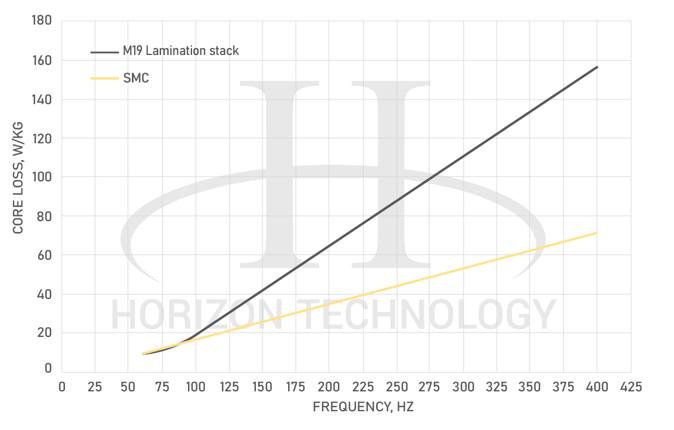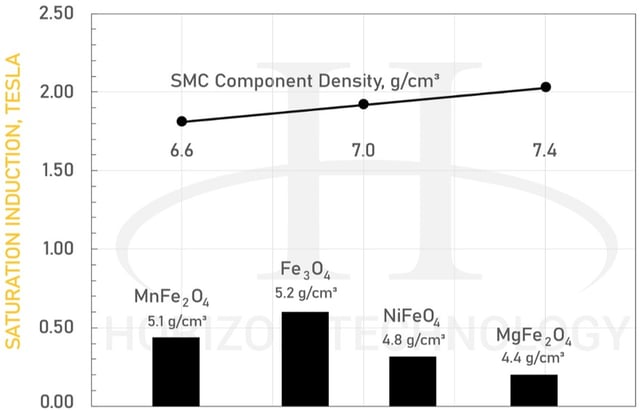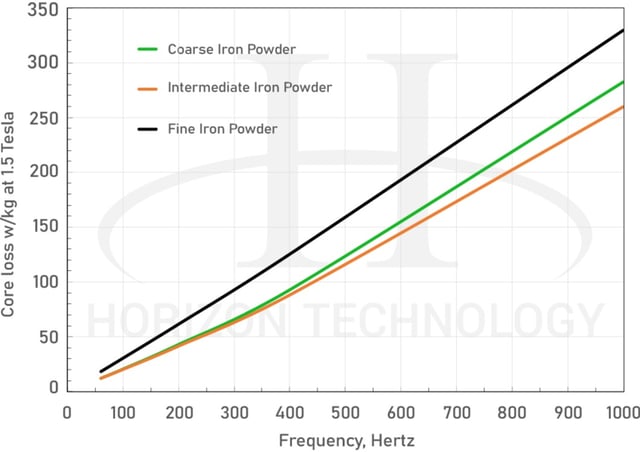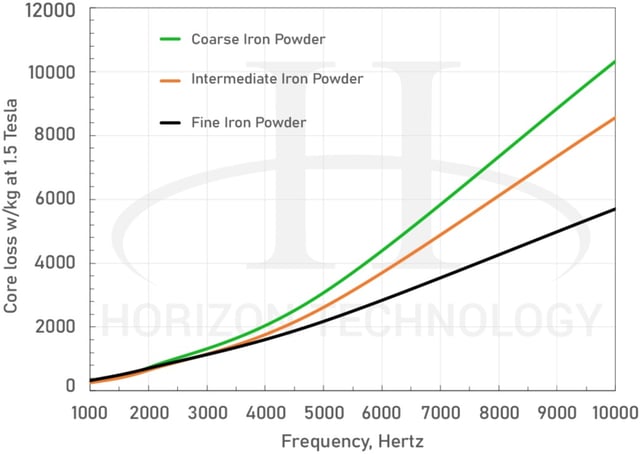Different applications require different motor types that operate at different frequencies. Similarly, today’s material solutions come in all shapes and sizes. (And if they don’t, you’re working with the wrong manufacturer.)
You already know high operating frequencies can produce a more efficient motor. In recent years, more engineers have been working their way up from standard 50-60 Hz designs to match the output to the demand.
However, if you design a motor with a broad range of variable frequencies, you’re potentially compromising more than you need to.
While a high-frequency electric motor produces more efficiency, the motor core losses ramp up dramatically due to heat in the motor. Suddenly, your “more efficient motor” has to spend more effort cooling itself, cutting your design’s potential off at the knees.
Using material customization for frequency and motor speed control in an AC electric motor has several advantages:
- Increased power efficiency from reduced core losses
- Enhanced product stability
- Noise reduction
Magnetic electric motor materials aren’t a one-size-fits-all concept. This article can help you find a better fit.
Current Material Shortcomings in Frequency & Motor Speed Control
One traditional way of achieving lower losses with high-frequency magnetic materials was to use thinner electrical steel lamination sheets (M19, for example). As you may be well aware, the cost and availability of these products can impede results.
Why do laminations become problematic? You can only roll them so thin, and the price skyrockets as the sheet shrinks.
When you’re stamping and laminating it, the material waste becomes a significant cost additive to your project.
Then there’s the inefficiency inherent to stacking steel lamination sheets. Look at the core loss formula for steel:
Core loss = constant x frequency2 x induction2 x thickness2 / resistivity
So, if your lamination is 2x the thickness, the core loss will be 4x greater. That’s why engineers strive for thinner pieces.
Unfortunately, it’s costly to do this, especially as you get into silicon steel materials. It also becomes mechanically hard to achieve. The forces required to roll thinner sheets go up exponentially.
Look at the other issues this material process causes:
- Stamping a component from sheet material means throwing away 25-50% of it as waste (or recycling it for marginal returns)
- Stacking laminations reduces component density due to air gaps, resulting in lower permeability and increased core losses
- Burrs stick out more in thinner sheets, potentially requiring a secondary operation
Another AC design option is high-frequency ferrite material. There’s a size issue here too, albeit a different one. You may have to build a high-frequency ferrite part 2-3x bigger than usual to avoid magnetic flux leaks.
So, after all this hard work with a steel lamination, you’ve still only achieved about 7.3 g/cm3 density. What if you had an alternative high-frequency material you could manipulate any way you want -- and still hit 7.3 density?
Let’s discuss how you can not only capture the full benefits of efficiency, but also tailor a material’s particle size to specific frequency ranges:
Potential Solution: SMC for Electric Motor Design
Many forward-thinking designs are migrating from lamination or traditional ferrite materials to soft magnetic composites.
Soft magnetic composite (SMC) materials are ferromagnetic powder particles coated with a uniform layer of electrical insulating film. Their primary application is in electromagnetic design, not the least of which is AC motor speed control.
SMC’s advantage is that it starts with a particle customized to meet your design’s needs.
What does this all mean? Look at the core loss data of this popular grade of SMC compared with common lamination steels:
.jpg?width=675&name=SMClinegraph%20(1).jpg)
This core loss chart only shows the efficiency of single-sheet lamination materials, not an assembled stack. Once your needs approach higher frequencies, you’ll have to spend more engineering time and energy to keep a lamination stack cooled.
Meanwhile, the SMC core loss data shows it’s 50-60% more energy efficient at as early as 500 Hz.
Now, what about stacked assemblies?

In the graph above, laminations fall behind at as low as 60 Hz compared to a frequently specified SMC grade. Even an SMC part of similar length to a stacked lamination assembly will produce similar performance as a much smaller SMC part.
Potential Solution: SMC vs. Traditional Thinking in Higher-Frequency Applications
Perhaps you’ve been looking for a high-frequency ferrite material in the 500-5,000 Hz range.
Could SMC displace traditional high-silicon steels or ferrites in industries like consumer electronics? Remember, ferrites have a low magnetic saturation point, whereas SMCs have significantly higher saturation.

The above chart compares saturation flux as a function of density in SMCs to fully dense ferrites. Even at the lowest density, an SMC material will have far higher saturation induction than a fully dense ferrite.
Now look at the same materials in terms of efficiency losses relative to frequency:


What do we learn from these charts?
- Coarse SMC material may be most beneficial up to 1,000 Hz
- Intermediate SMC alternatives are ideal up to 4,000 Hz
- SMCs with extremely fine particle distribution excel up to 10,000 Hz and beyond
SMC again shows it’s a flexible option for reducing AC core losses.
Other Electric Motor Material Properties to Consider
Some properties to note as you consider the path forward for your design:
- Resistivity measures a material’s ability to fight back against eddy currents that generate unwanted heat. Ferrites have resistivity in the 1,000,000s, steel has resistivity in the 10s, and SMC has it in the 10,000s.
- SMCs may not give you the permeability levels possible with ferrites. High resistivity tends to produce high permeability. However, certain alloying elements used in both SMCs and steel laminations can actually increase resistivity while hurting permeability.
In short: Consider your end-use needs and ask for a suitably customized solution from Horizon Technology.
Freedom of Frequency, and Freedom of Performance
Who knew particle size in powder metallurgy could be such a liberating feature for electric motor design?
SMC provides the flexibility to select a raw material based not only on shape, but also on the frequency and performance levels your project needs.
To learn more about what soft magnetic materials can bring to the table in AC machine design, check out this SMC visual primer:



